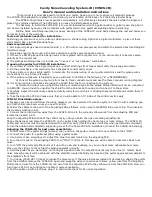
3.3.10
Plotting Commands
As previously mentioned, there is very little reason to plot or conduct graphic operations in the Graph
Mode. All of the operations conducted through the GPIB can be accomplished in the Marker Mode. (This
is not completely true in the manual mode of operation.) Therefore, it is assumed that the PPM is in the
Marker Mode of operation when executing any of the commands listed in this section for making
hardcopy plots.
As described in the Stand Alone Plot Output Mode description, the PPM has two different plotting
modes. The Stand Alone Plot mode should not be used when the instrument is under the control of a
remote controller. Also, the Stand Alone Plot mode should not be initiated from the front panel of the
PPM when the instrument is under GPIB control.
☛
NOTE: For proper system operation, make sure that no active controller is on the bus when
the front panel function is initiated.
Before a plot is made, you might want to enter a part number or code number that can be used for
reference. These commands are summarized in the following description.
PLCNaaaaaaaaaaaa
Set Code Number for plot to ASCII string represented by up to 12 characters (a).
PLPNbbbbbbbbbbbb
Set Part Number for plot to ASCII string represented by up to 12 characters (b).
PLOT
Plot pulse profile currently displayed. Marker information will be plotted if the PPM
is in the marker sub-mode. Pulse information will be plotted if the PPM is in the
pulse sub-mode.
There is also a sample program in Section 3.2.5 showing how to format the required
listen and talk addressing procedures.
PLTT
This is the same as the PLOT command, but at a slower speed for transparency plots.
PLTM
Change to Marker sub-mode, and then Plot.
PTTM
Same as PLTM, but at a slower speed for transparency plots.
☛
NOTE: If you want to save a plot on disk exactly as it would have been plotted by a digital
plotter, the entire HPGL plot string can be entered into a variable in the GPIB controller
using the following program:
10 DIM A$(CCCCC)
! NEED VARIABLE SIZE
20
! HERE
30
OUTPUT 704;PLOT
40
ENTER 704;A$ ! ENTER PLOT HPGL
50
! COMMANDS.
60
! ADD PROGRAM LINES HERE TO
70
! STORE A$
•
•
100
END
A$ can be recalled later from the disk file for plotting.
Series 8500A Peak Power Meters
3-34
Manual No. 20790, Rev C, November 1998
Summary of Contents for 8501A
Page 12: ...Series 8500A Peak Power Meters x Manual No 20790 Rev C November 1998 ...
Page 16: ...Series 8500A Peak Power Meters xiv Manual No 20790 Rev C November 1998 ...
Page 18: ...Series 8500A Peak Power Meters xvi Manual No 20790 Rev C November 1998 ...
Page 74: ...Series 8500A Peak Power Meters 2 48 Manual No 20790 Rev C November 1998 ...
Page 156: ...Series 8500A Peak Power Meters 4 30 Manual No 20790 Rev C November 1998 ...
Page 180: ...Series 8500A Peak Power Meters 5 24 Manual No 20790 Rev C November 1998 ...
Page 230: ...Series 8500A Peak Power Meters 8 2 Manual No 20790 Rev C November 1998 ...
Page 236: ...Series 8500A Peak Power Meters A 6 Manual No 20790 Rev C November 1998 ...
Page 262: ...Series 8500A Peak Power Meters Index 8 Manual No 20790 Rev C November 1998 ...
















































